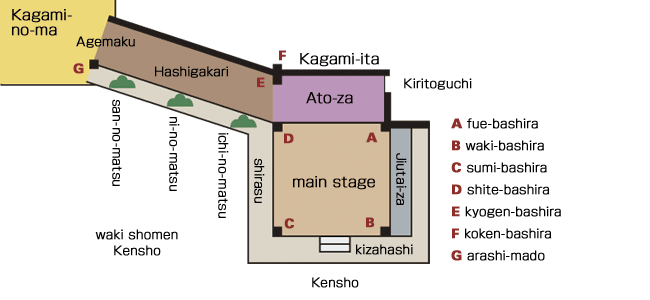 |
| Noh Stage at Night |
 |
| Noh stage at |
 |
| With the Great Torli (sacred gate) on Miyajima Island |
- Hashira
- The main stage has four hashira or bashira (columns): the sumi-bashira, waki-bashira, shite-bashira, and the fue-bashira. As the shite wears a mask while performing, the hashira are a very important tool for the shite to gauge their location on stage. The sumi-bashira is a particularly important marker and also has the name metsuke-bashira or “eye-fixing column.”
- Kagami-ita
- The back wall of a noh stage is called the kagami-ita on which a pine tree called the oi-matsu is painted. This is said to be the eternal backdrop of noh. The Yōgō no matsu (The Yōgō Pine Tree) is said to be the model for which the kagami-ita is based, and can still be found at the Kasuga Shrine in Nara. While the noh stories may change, the backdrop does not. All noh are performed in front of the kagami-ita.
- Jiutai-za and Ato-za
- Off to the right side of the main playing area is the jiutai-za (seating for the chorus). The back of the stage is known as the ato-za and is the spot reserved for the hayashi (musicians) and the koken (stage attendants). In contrast to the main playing area where the boards lie vertically, in the ato-za the boards are laid horizontally, and is also known as the yoko-ita.
- Hashigakari
- Running from the ato-za off to the left of the main playing area is the hashigakari (bridgeway). The hashigakari is used not just for entrances and exits, but also as another playing area for some important scenes. As opposed to the openness of the main playing area, the hashigakari is linearly laid out and consequently aids in creating a feeling of depth. The shite then can use the hashigakari to better express their mental state.
- Agemaku and Kiridoguchi
- There are two entrances to the noh stage, the agemaku and the kiridoguchi or kirido. The agemaku is located at the end of the hashigakari and is the five-colored curtain that is raised and lowered for the entrance and exit of the shite, waki, tsure, waki-tsure, kyōgen, and hayashi. The kiridoguchi is located on the right side of the ato-za and is a small sliding door that is used for entrances and exits of the kōken (stage attendants) for both the shite and the hayashi, as well as for the jiutai (chorus).
- Kagami-no-ma
- The kagami-no-ma (mirror room) is located behind the agemaku and is where the shite puts on the mask being used for the noh. This is also where the hayashi play oshirabe (warm-up music). It can be said that when the shite and hayashi enter this area, the noh has begun.
- Kensho
- The audience seating area in a noh theatre is called the kensho. The seats located in front of the stage are called shōmen, while the seats on the left side of the stage are called the waki shōmen. Audience members sitting in the shōmen section have the best view of the mask effects, while the advantage of sitting in the waki shōmen is the close proximity to the hashigakari. In between the two are the naka shōmen seats which lie in front of the metsuke bashira. Older noh theatres have tatami rather than seats, while almost all large modern noh theatres are made with fixed seats. Some noh theatres are also equipped with balconies.
- FROM: http://www.the-noh.com/en/world/stage.html, accessed Aug. 23, 2014.
This information about the Noh stage is from a wonderful site: the-noh.com.
The noh stage is constructed from hinoki (Japanese cypress). At the back of the stage is the kagami-ita (back panel, usually displaying a painted pine tree). In the front of the stage is the kizahashi (decorative staircase). Coming off the left side of the stage is the hashigakari (bridgeway). At the end of the hashigakari is the agemaku
(curtain) which marks the entrance to the backstage area. It is thought
that this current standard stage construction was established just
before the reign of the well known Shōgun Oda Nobunaga (circa 1550). The
Northern Noh Stage, located Nishi Honganji Temple in Kyoto, is the
oldest standing stage of this type of construction and is said to have
been built by Toyotomi Hideyoshi.
The complete noh stage is comprised of the hon-butai (main playing area), hashigakari (bridgeway), ato-za (seating section for musicians and stage attendants) and the jiutai-za (seating section for the chorus). The main playing area is 5.4m per side.
 |
 |
| Noh Production, Meiji era, 1897 by Tsukioka Kogyo (月岡耕漁) |
INFO ON NOH PROPS: http://www.coreofculture.org/noh.html
A SEARCHABLE GLOSSARY OF NOH TERMS: http://db2.the-noh.com/edic/










Post a Comment